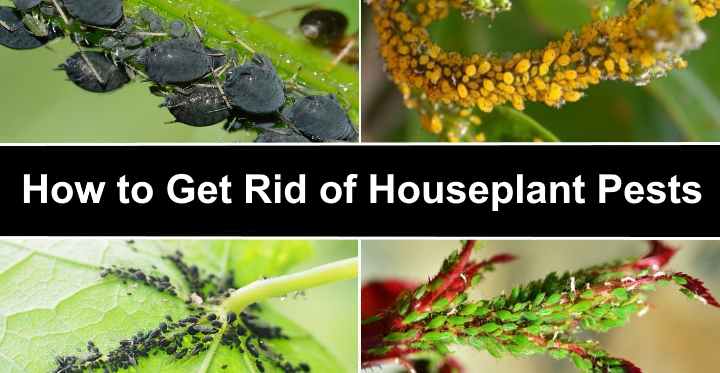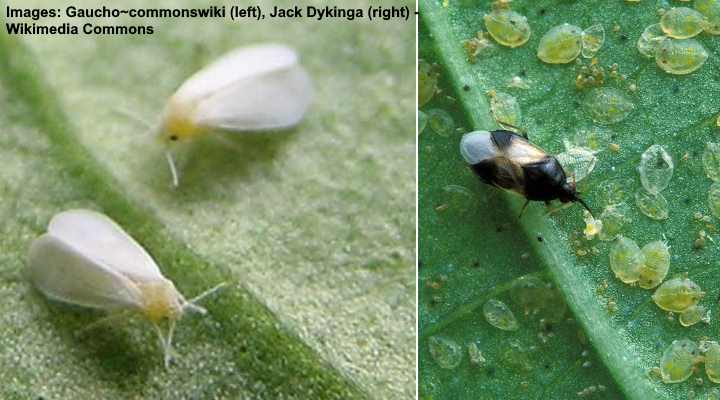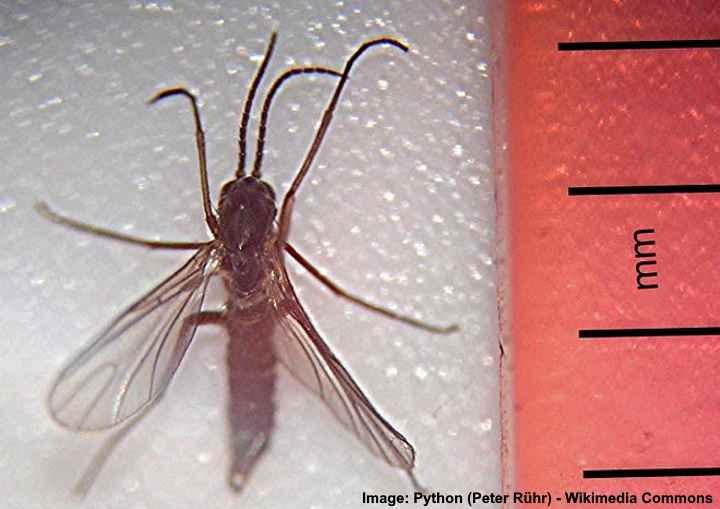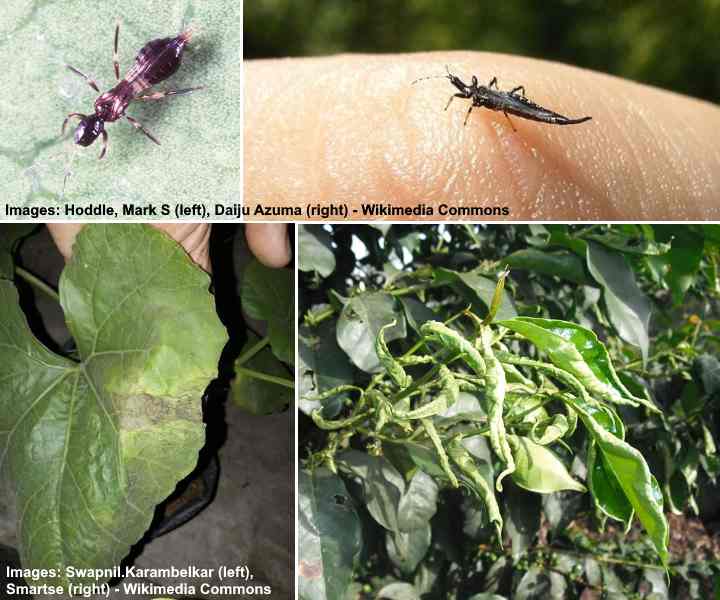How to Get Rid of Bugs in Houseplants: Natural Ways to Kill Bugs on Indoor Plants

Getting rid of bugs in houseplants can be challenging. Aphids, spider mites, thrips, and mealybugs can seem to come from nowhere. And, just when you thought you got rid of these indoor plant pests for good, they appear again. It’s essential to act quickly at the first signs of a houseplant bug or pest infestation. These pests can end up sucking the life out of your prized indoor plants.
The best treatments to get rid of bugs in houseplants are neem oil for its natural pesticidal properties, insecticidal soap because it kills plant pests on contact, and diatomaceous earth (DE) because it is non-toxic, yet kills bugs. In addition to these natural pest remedies, ensure growing conditions are optimal for houseplants. You may also have to change the soil.
Common houseplant pests can live in the soil, attach themselves to stems, live under leaves, or fly from plant to plant. The most destructive plant pests—spider mites, aphids, scale insects, and mealybugs—suck on plant juices. If you don’t eradicate the pests, their eggs and larvae, they could end up killing your plant.
In this article, you will learn how to get rid of bugs in houseplants. You will also find out how to identify some plant pests so that you can use the appropriate natural pest control remedy.
Overview of Common Houseplant Pests
Houseplant pests can be mites, flies, bugs, or other sap-sucking insects. These crawling or flying pesky insects can quickly infest indoor plants. You might see them emerging from the soil, flying around your plant, or sticking to stems and not moving at all.
Apart from the nuisance factor—after all, who wants flies in their home—many bugs on plants do a lot of damage. Yellow leaves, weak growth, leaf drop, or wilting stems are all the results of pest infestations.
Fortunately, there are steps you can take to eliminate the bugs in houseplants. Some natural remedies for plant bugs can be effective without filling your home with toxic chemicals. All you need is some patience, determination, and diligence to kill bugs on indoor plants.
Why Do Indoor Plants Get Bugs?
So, you may be wondering how you got bugs in houseplants in the first place. Whitefly, aphids, fungus gnats, and mealybugs seem to have the ability to appear from thin air. Unfortunately, dealing with bugs or tiny flies indoors can be more problematic than outdoors.
Here are some reasons why you get insects on indoor plants:
Soil—Using soil from gardens can introduce all sorts of bugs into your home. There could be microscopic eggs or larvae in the ground that end up in your plant pots. Always buy a sterile commercial potting mix from a reputable garden store.
Lack of predators—There are generally no predators in the home that kill pests indoors and feed on them.
Growing environment—Poor light, low or high humidity and certain temperature can create an environment where houseplant bugs thrive. Some common household bugs love dry climates, and homes have less humidity than outdoors.
Damp soil—Too much moisture in potted plants can cause fungus gnats to reproduce rapidly and become very active.
Bringing plants inside from outdoors—Many plants such as plants in hanging baskets grow well outdoors in summer but need to be inside during winter. Unfortunately, you could bring in unwanted guests from outside.
Stressed plants—Plants that grow in poor conditions—not enough light, water, or fertilizer—are more susceptible to plant bugs than healthy plants.
How to Identify Common Indoor Plant Pests (With Pictures)
The key to eradicating bugs from house plants is to know what kinds of pests are affecting your indoor plant. Although some home remedies for killing indoor plant pests work on many bugs, part of successful treatment involves getting the right growing environment for houseplants.
Let’s look at some ways to identify common houseplant bugs to know how to get rid of them.
Small white flies on houseplant leaves—This is a sign of whitefly, and these tiny white flies suck on the sap of plants. In time, plant leaves become yellow and die. Home remedy for these pests: neem oil spray and yellow sticky cards.

The tiny whitefly is a pest that can usually be found on the underside of the houseplant’s leaves. Right image: A bug feeding on whitefly larvae
Tiny spiders or spider webs on indoor plants—Noticing fine webbing under leaves is a warning sign of spider mites. These minuscule spiders are hard to spot, so the spider webs are the best way to identify them. Home remedy for these houseplant bugs: neem oil with insecticidal soap.

Left picture: spider mites on a lemon plant. Right: red spider mite (enlarged image)
White fluff like cotton wool on houseplant stems and leaf joints—Mealybugs look like fluffy white bits or mildew on stems. If you don’t kill these houseplant bugs quickly, they will destroy your plant. Home remedy to get rid of these bugs in houseplants: Treat with rubbing alcohol to kill the tiny white pests.

Mealybugs look like little white fluffy bugs on plants
Tiny bugs in houseplant soil—Fungus gnats lay their eggs in soil where larvae develop into minute black flies. These small flying insects look similar to fruit flies. Home remedy for flying fungus gnats: Apply a solution of Bacillus thuringiensis var. Israelensis (bacteria used as biological control) to the soil to exterminate gnat eggs and larvae.
Learn about other effective ways to get rid of fungus gnats on houseplants.

Fungus gnats (soil gnats) are soil dwelling small black houseplant pests that feed on fungus
Clusters of red, brown, yellow or green bugs on indoor plants—Aphids, also called greenfly or blackfly, are common bugs in houseplants. They feed on the juice of your houseplants, slowly killing them. You may even notice a sticky substance on stems if you’ve got an aphid problem. Home remedy for the bugs on plants: Wash your plants with insecticidal soap or spray with neem oil.
Learn about other effective natural ways to get rid of aphids.

Aphids are pests that can look like tiny green bugs but can also have red, yellow, black or white color
Small, slender yellow, black, or brown insects with pointed tails—Thrips are long skinny bugs that crawl and fly. If you don’t get rid of these indoor plant pests quickly, your houseplant will end up with brown leaves that fall off. Home remedy: Insecticidal soap or neem oil solution.

Thrips include many species which are usually black or brown (upper pictures). Lower images: Leaf suffering from thrips (left). Coffee tree leaves rolled up by thrips damage (right)
Brown bumps on stems—It’s easy to think these are bits of plant growth, but the hard bumps are actually scale insects. These brown insects stick to parts of the leaves and slowly suck the life from your plants. Home remedy for scale: Apply rubbing alcohol with a cotton bud to get rid of these bugs in houseplants.

Left picture: A cluster of scale insects on a stem. Right image: White waxy scales on cycad leaf
How to Get Rid of Bugs in Houseplants
There are a few steps to take to get rid of bugs on indoor plants before applying natural home remedies. The steps are as follows:
- Identify the type of bug, mite, pest, or fly that has infested your plant.
- Isolate the plant from your other houseplants to contain the infestation.
- Try to determine the extent of the infestation.
- Continue using the home remedies for houseplant bugs after you think all pests have been killed.
- If you repot a houseplant or prune off diseased leave, always sterilize equipment and new pots.
Here are some home remedies for bugs on indoor plants:
How to Kill Bugs on Indoor Plant Leaves
The majority of bugs in houseplants are found on the underside of leaves, on stems, or in flower buds.
Insecticidal soap—Buy organic insecticidal soap to wash plant leaves and stems. Or, you could try your own remedy at home to kill bugs on houseplant leaves. This is what you should do:
- Mix 1 tsp. of mild organic liquid soap in 33 fl. oz. (1 l) of warm water in a spray bottle.
- Shake well to mix.
- Spray the soap remedy directly onto infected parts of the plant.
- Wipe the leaves to remove dead bugs.
Neem oil solution—An organic neem oil home remedy is effective against many types of bugs on leaves of indoor plants. Use neem oil for spider mites, aphids, thrips, mealybugs, whiteflies, and fungus gnats. To make a bug-busting neem oil home remedy, this is what you should do:
- Mix 1.5 tsp. organic neem oil and 1 tsp. mild liquid soap in 33 fl. oz. (1 l) of warm water.
- Put in a spray bottle and mix thoroughly.
- Use your houseplant home remedy bug solution to spray all parts of the affected plant.
- Use once a week to get rid of bugs and once every four weeks for prevention.
Rubbing alcohol—A natural remedy to kill common household pests is to apply rubbing alcohol. Soak a cotton bud in the alcohol and apply directly to the bugs. The alcohol will kill the bugs on contact.
How to Get Rid of Bugs or Insects in Houseplant Soil
The most common reason for bugs affecting potting soil is to do with moisture. Common houseplants hate sitting in waterlogged, soggy soil. The dampness not only leads to root rot and weak plant growth, but it also attracts various types of bugs such as fungus gnats.
As a general rule, only water houseplants when the top 1” or 2” (2.5 – 5 cm) of soil is dry. Thoroughly water the roots until water drains out the bottom. Then, make sure that your potted houseplant never sits in a pool of water.
What should you do if bugs have infested your potting medium?
Repot your plant—The first step is to remove the potting mix and replace it with fresh soil. This is what you should do:
- Gently remove the plant from its container.
- Put all the soil in a disposable bag and remove all the dirt from the roots.
- Check for signs of root rot and prune dead or diseased roots as necessary.
- If you are repotting in the existing pot, make sure and sterilize it.
- Half-fill with fresh potting soil and place your plant in.
- Fill the remaining space with the soil, making sure the plant is growing at the same height as before.
Neem oil soil drench—Using neem oil to drench the soil is an effective way of killing any bugs living in plant pot soil. This neem oil solution can also help prevent fungal diseases from affecting your plant. Use neem oil this way to kill pests in plant soil:
- Mix 1 tbsp. neem oil, 1 tsp. mild liquid soap, and one-quart (1 l) of warm water.
- Pour the solution through the soil and let it drain out the bottom.
- Use once a month to help kill off tiny white bugs in soil.
Food grade Diatomaceous earth (DE)—This naturally occurring white powder is non-toxic. Diatomaceous earth is abrasive, and it kills some bugs when they come into contact with it by destroying their outer layer. Sprinkle on dry soil around your plant to help control houseplant bugs. Diatomaceous earth needs to be dry to be effective so you’ll need to sprinkle it again after watering your plants.
How to Get Rid of Flying Pests from Houseplants
Getting rid of whiteflies, aphids, and other flying bugs is more challenging. As soon as the plant is disturbed, the tiny white, black, or green flies tend to fly off. So, you need a two-step attack to rid your houseplant of flying pests.
- Step one—Use a neem oil soil drench weekly to kill any eggs or larvae in the soil.
- Step two—Reduce fly populations by using yellow sticky traps.
Why Use Natural Pesticides to Get Rid of Houseplant Bugs?
Even though it may seem a quicker option to use chemical pesticides to get rid of houseplant bugs, it always best to use natural products to kill bugs on houseplants. Synthetic pesticides are potentially harmful to everyone living in the home. Also, many indoor plant bugs develop resistance to chemicals.
How to Prevent Houseplant Pests
Because getting rid of bugs in houseplants is so challenging, it’s best to prevent any infestations in the first place. How can you prevent bugs from damaging your indoor plants? Here are a few ideas.
- Always check for signs of pests or bugs before bringing new plants into your home. Isolate new plants from your other houseplants for a few weeks to ensure they are bug-free.
- Monitor houseplants regularly for evidence of bugs. The earlier you spot an infestation, the easier it is to deal with it.
- Always sterilize pruning shears or plant pots.
- Thoroughly check the houseplant for bugs if you bring them back indoors after the summer.
How to Keep Houseplant Bugs Away for Good
When you finally get rid of bugs on indoor plants using home remedies, you never want them to return. So, constant vigilance is essential to make sure that bugs, mites, pests, and flies stay away from your beloved houseplants.
Healthy plants are more resistant to disease, and they don’t attract pests. Try to avoid conditions that stress plants out. Some of these can be:
- Low light if your plant requires bright, indirect light.
- Dry air and too little humidity.
- You are not feeding your plant enough.
- Watering too much or too often results in root rot and fungal infections.
FAQ: Getting Rid of Common Houseplant Pests
Here are answers to many more questions you may have about caring for houseplant if they are infected with bugs:
Why do indoor plants attract gnats and other bugs?
Bugs, pests, and gnats are attracted to plants due to growing conditions in your home. High soil moisture levels, lack of air circulation, or high or low humidity create environments where houseplant bugs thrive.
Healthy, robust houseplants are usually hardy against pest infestations and diseases.
What should I spray on houseplants to kill bugs?
The best natural bug sprays for indoor plants are insecticidal soap or neem oil solutions. Before applying any natural solution, test it on one plant leaf to see if there are any adverse reactions.
Will soapy water damage houseplants?
Soapy water shouldn’t affect houseplants. Washing infected leaves and stems in a mild liquid soap solution can help to kill bugs in houseplants. However, soap doesn’t have a residual effect, so you’ll have to wash plants regularly to get rid of pests altogether.
Are bugs in houseplants or potting soil normal?
Although getting pests in indoor plants is common, it’s not normal. But even the most experienced houseplant owner needs to deal with bug infestations from time to time.
Related articles:
